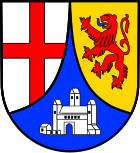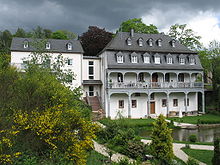Throne corners
| coat of arms | Germany map | |
|---|---|---|

|
Coordinates: 49 ° 44 ' N , 6 ° 59' E |
|
| Basic data | ||
| State : | Rhineland-Palatinate | |
| County : | Bernkastel-Wittlich | |
| Association municipality : | Thalfang at the Erbeskopf | |
| Height : | 380 m above sea level NHN | |
| Area : | 1.45 km 2 | |
| Residents: | 125 (Dec. 31, 2019) | |
| Population density : | 86 inhabitants per km 2 | |
| Postal code : | 54426 | |
| Area code : | 06504 | |
| License plate : | WIL, BKS | |
| Community key : | 07 2 31 019 | |
| Association administration address: | Saarstrasse 7 54424 Thalfang |
|
| Website : | ||
| Local Mayor : | Detlef Jochem | |
| Location of the local community Dhronecken in the district of Bernkastel-Wittlich | ||
Dhronecken im Hunsrück is a municipality in the district of Bernkastel-Wittlich in Rhineland-Palatinate . It belongs to the Verbandsgemeinde Thalfang am Erbeskopf .
geography
Dhronecken is located between Trier and Saarbrücken , on the Hunsrückhöhenstraße , 9 km from the Autobahn 1 in the direction of Morbach . In the Dhronecker Mulde, the confluence of two streams forms the Kleine Dhron , which flows into the Dhron river and thus the Moselle .
history
Early days
Dhronecken is located in what can be proven to be the oldest trunk and core area of the Celts , which dates back to 500 BC. Chr. By the middle Danube as far as Lorraine extended ( Hallstatt culture and) only in later centuries after France extended. Grave fields, but especially the hill fortresses, bear witness to those times; the so-called Hunnenring - not far from Otzenhausen - is a mighty example, and also in the outskirts of Dhronecken, on the Röderberg, there is a smaller, oval Celtic rampart.
At that time, an independent culture developed in the Eifel and Hunsrück regions , that of the Treveri , which was spatially divided into a western and an eastern group. Today's Dhronecken belonged to the western group. There are no written sources, but this independent culture can be proven archaeologically through the costumes of the buried and through the shapes and decorations of the grave goods, especially the clay vessels.
The Celtic Treveri claimed of themselves to be of Germanic origin. As Caesar reported in detail in his eight books ( De Bello Gallico ) about the war with the Celts, they had a reputation for particular bravery and had by far the most important cavalry "in all of Gaul ".
Roman times
With Caesar's victory over the Celtic tribes in 51 BC. Today's Dhronecken became part of a Roman province called Belgica Prima (see: Belginum Archaeological Park ). At that time a Roman settlement was established near Dhronecken, also on the Röderberg , with a sanctuary, pilgrim houses and restaurants. Also remarkable is the large settlement of Sarmatians between Dhron and Nahe, that is, of non-Germanic peoples from today's Russian steppe. With the Germanic barbarian invasions , the occupation ended by the Romans , after numerous uprisings and Celtic first incursions of the Germans . The last Roman coins from the Dhroneck area date from around 400 AD.
Franc time
After the turmoil of the Great Migration , the Franks occupied the Hunsrück. A tribe called "Moselfranken" today had separated from the Rhine Franconians around 420 and moved westward. As " Moselle Franconian " their language lives on to the present day and connects as a dialect the Dhronecker Land with Trier and the northern Saarland , also with Luxembourg , whose national language, besides French and High German, has remained Moselle Franconian.
Politically, the Franks were united by their kings. They divided the country into Gaue, whereby Dhronecken was assigned to the Triergau and thus to the Trier bishop, which was confirmed by documents by the kings Pippin and Charlemagne around the year 800.
Middle Ages to the present
During the Middle Ages, it was split up into smaller territories. The Troneck fortress became the seat of power of the so-called Wildgrafen and thus the entire Thalfang ( Talevangero marca ). As early as 1223, Wildgraf Conrad swore the Count of Luxembourg the vassal oath. Disputes over inheritance and independence did not fail to appear, but around 1350 Baldwin , Archbishop and Elector of Trier, finally managed to take Dhronecken Castle “under his umbrella” as a military base in Trier.
In 1564 the Wildgraves and now Rheingrafen introduced the Reformation in the Thalfang region, which since then has been surrounded by the area of the Catholic Kurtrier like an island. This, too, caused the incredible devastation and horror that Dhronecken Castle and its serf residents in the Thirty Years' War (around 1630), the Wars of Conquest of Louis XIV (around 1680), the War of the Palatinate Succession (around 1690) and the War of Spanish Succession (around 1700) had to suffer. It was not until the French Revolution that serfdom ended in 1794 , but it also meant the dissolution of the Dhronecken office and the almost complete assignment to the mayor's office of Thalfang, and thus since 1815 to the Kingdom of Prussia .
From 1803 the entire aristocratic property was auctioned, largely acquired by the Heusner bailiff and judge family from Dhroneck. The serfs themselves, since they had no assets, were largely left with nothing. From then on there was poverty. Around 1840, many residents from Dhronecken and the surrounding area decided to emigrate to America or to the areas of Austria liberated from the Turks. Only the industrialization of the Ruhr and Saar brought some prosperity again.
In 1903 Dhronecken was opened up by the railway line from Morbach to Hermeskeil. During the Second World War, Dhronecken was therefore an important supply point for the construction of the surrounding Siegfried Line fortifications , but also, in the last years of the war, for V2 rockets , which were fired from a nearby wooded area under great secrecy from the residents. The Allies bombed Dhronecken, but the greatest damage was caused by German pioneers. Before they fled towards Thalfang on bicycles, they blew up all the bridges in the village.
Since 1946 the place has been part of the newly formed state of Rhineland-Palatinate in the same year.
Population development
The development of the population of Dhronecken, the values from 1871 to 1987 are based on censuses:
|
|
Municipal council
The municipal council in Dhronecken consists of six council members, who were elected in a majority vote in the local elections on May 26, 2019 , and the honorary local mayor as chairman.
Culture and sights

Buildings
Dhronecken Castle
In 752 AD, a document mentions the Dhron for the first time as "Drona", which, together with its location in the confluence, in the corner, of two streams, gave the castle and the village its name.
Around 1300 a knight Conrad von Tronecken is mentioned for the first time in writing, a little later the "Feste Troneck", which is probably much older. Destroyed several times, by Cologne, Imperial and French troops, and finally by an earthquake, only remnants are left, but a corner tower can still be climbed. From 1309, the castle was the retirement home of the last Templar provincial master or grand prior for Upper Germany, Friedrich Wildgraf von Kyrburg .
Farm buildings were built on the foundations of the old castle in modern times, including a larger, towering building called the "castle" and today used as the Hochwald forestry office. In addition, a barn with a beam structure serves as a community center for the community of Dhronecken. The beautifully situated castle gardens have been partially planted and cared for since 1985.
Below the castle is a natural playground on both sides of a stream. A water ford with spring stones, a forum-like play and meeting place rising up the slope, made of mighty stone blocks, wooden walkways over natural marshy terrain, playhouses, a suspension bridge and a slide are attractions for children and adults alike.
- Connection to the Nibelungen saga
According to a legend, Dhronecken is said to be the home of the Nibelung hero Hagen von Tronje , who is called "Hagen von Troneg" in the most important versions of the Nibelungenlied (also, in the dative: von Tronege Hagene, born from Tronege, helt von Tronege, von Tronegaere ). However, there is no reliable evidence, other places also claim this, but in Germanic antiquity the village of Dhronecken is mentioned in the first place.
Residential house of the manager of the Dhronecken Castle from the Wild and Rhine Counts
As dendrological studies show, the house was built around 1700 in the Baroque style. It belonged to the administrator of the Dhronecken castle , Friedrich Christian Heusner, who was both bailiff and judge. This house has been a listed building since 1981 and has been refurbished in such a way that the exterior has almost been restored to its original shape. Inside, the pillared hall with turned 4 to 5 m high oak columns has been preserved. What sets this house apart from a cultural and historical point of view is the impressively harmonious design of the garden side, its mansard roof, its arbor (garden loggia) made of turned oak logs and oak balusters . The family of the builder Heusner came from Franconia , where, taking Italy as a model, balconies standing on pillars were common at that time. Today the property is called "Balterie", also in memory of the Hagens von Troneg family, who are named Baldur in the Nibelungenlied.
Decker Mill
A sawmill that is still functional today is the Decker Mühle. It was first mentioned in the Dhronecker Chronicle around 1750.
Water tower
A water tower , built in 1900, which as a water reservoir for steam locomotives in the former railway station served
traffic
The Dhronecken station was on the Hunsrückquerbahn, which has now been closed . The L 153 leads through the village , in the south it is affected by the L 152 .
Born in Dhronecken
- Anton Hisgen (1809–1864), Prussian district administrator in the Wittlich district
Web links
- Dhronecken at www.hunsrueck-nahereise.de
- Link catalog on the topic of droning corners at curlie.org (formerly DMOZ )
Individual evidence
- ↑ State Statistical Office of Rhineland-Palatinate - population status 2019, districts, communities, association communities ( help on this ).
- ^ Fritsch, T. 2010. Research project Terrex: Celtic ring wall near Otzenhausen.
- ^ Cüppers, The Romans in Rhineland-Palatinate, 1990
- ^ Carla Regge: Dhronecken - Chronik des Dorfes , Trier: Sonnenburg Verlag, 1991
- ↑ State Statistical Office Rhineland-Palatinate - regional data
- ^ The Regional Returning Officer Rhineland-Palatinate: Local elections 2019, city and municipal council elections
- ^ Leopold von Ledebur : General Archive for the History of the Prussian State , Volume 16, 1835, p. 112; (Digital scan)
- ↑ Real Lexicon of Germanic Antiquity . Lim. by Johannes Hoops. Vol. 13. 2. revised. Berlin 1999 edition, p. 347.




